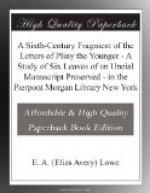Another curious bit of testimony appears at the beginning of the third book. The scribe of B[36] wrote the words NESCIO—APUD in rustic capitals, occupying therewith the first line and about a third of the second. This is not effective calligraphy. It would appear that he is reproducing, as is his habit, exactly what he found in his original. That original might have had one full line, or two lines, of majuscules, perhaps, following pretty closely the lines in _{Pi}_, which has the same amount of text, plus the first three letters of SPURINNAM, in the first two lines. If B had _{Pi}_ before him, there is nothing to explain his most unusual procedure. His original, therefore, is not _{Pi}_ but an intervening copy, which he is transcribing with an utter indifference to aesthetic effect and with a laudable, if painful, desire for accuracy. This trait, obvious in B’s work throughout, is perhaps nowhere more strikingly exhibited than here.
[Footnote 36: See plate XIV.]
[Sidenote: _{Pi} the direct ancestor of BF with probably a copy intervening_]
If _{Pi}_ is the direct ancestor of BF, these manuscripts should contain no good readings not found in _{Pi}_, unless their writers could arrive at such readings by easy emendation or unless there is contamination with some other source. From what we know of the text of BF in general, the latter supposition may at once be ruled out. There are but three cases to consider, two of which may be readily disposed of: 64, 3 proferenda] conferenda BF CONFERANDA _{Pi}_; 64, 4 conprobasse] (comp.) BF COMPROUASSE _{Pi}_. These are simple slips, which a scribe might almost unconsciously correct as he wrote. The remaining error (63, 28 SIBI to si) is not difficult to emend when one considers the entire sentence: quibus omnibus ita demum similis adolescet, si imbutus honestis artibus fuerit, quas, etc. It is less probable, however, that B with _{Pi}_ before him should correct it as he wrote than, as we have already surmised, that a minuscule copy intervened between _{Pi}_ and B, in which the letters bi were deleted by some careful reviser. Two other passages tend to confirm this assumption of an intermediate copy. In 65, 6 (tum optime libertati venia obsequio praeparatur), B has optimae, a false alteration induced perhaps by the following libertati. In _{Pi}_, OPTIME stands at the end of the line. The scribe of B, had he not found libertati immediately adjacent, would not so readily be tempted to emend; still, we should not make too much of this instance, as B has a rather pronounced tendency to write ae for e. A more certain case is 66, 7 fungar indicis] fungarindicis ex fungari dicis B; here the error is easier to derive from an original in minuscules in which in was abbreviated with a stroke above the i.




